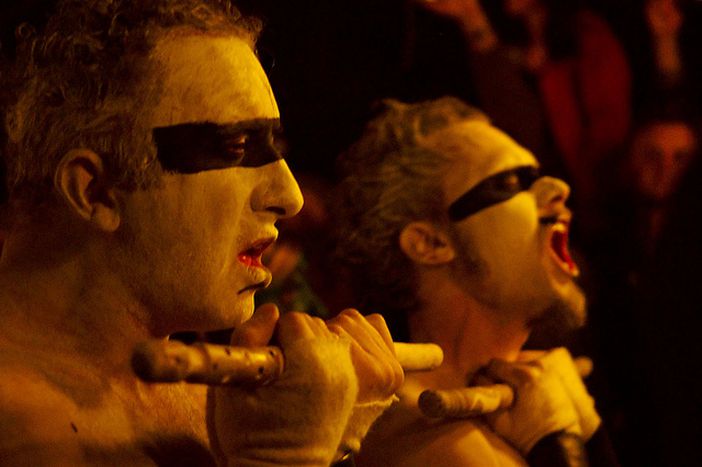
A Pole in Dublin on similarity between Irish Gaelic and Belarusian languages
Published on
The history of Gaelic’s demise as the main language spoken in Ireland seems shocking for Poles coming to the country; language preservation was central to much of their own history. But Poles have a similar example close to home. While Gaelic is fought over and protected, Belarusian has become a losing party in a political war. First in a special series from the folks at cafebabel Dublin
When I first land at Dublin airport from Poland, I struggle to understand that inscriptions in Gaelic leading to ‘Sli Amach’s ‘Busanna’s and ‘Tacsai’s (exits, buses, taxis) serve no instructive purpose for the locals. The two languages – one Celtic and one Slavic - have hardly anything in common in terms of grammar, vocabulary or pronunciation. Yet Gaelic and Belarusian share a history of linguistic colonisation and decline. The stories are strikingly similar and happened roughly at the same time.
Speaking in tongues
At one of the Dublin’s walking tours, tourists learn that up until the 1840s when the great Irish famine broke out, Gaelic was spoken by at least 50% of the island’s population. Massive starvation and emigration led to the population decreasing by 20 to 25%. Gaelic was swallowed up by Hiberno-English (Irish English); until 1922, Ireland was part of the United Kingdom, which had a hostile policy towards national languages of its provinces. According to the 2011 Irish census, only 94, 000 native Gaelic speakers use the language at home.
Read 'The lost art of speaking Belarusian in Belarus' on cafebabel.com
Likewise, Belarusian experienced its first wave of decline in the 19th century. Until 1795 it was the major language in the Grand Duchy of Lithuania, when the Belarusian-speaking part came under Russian rule. The Russian Empire conducted a systemic policy of ‘russification’: Russian was the only language permitted in schools and public administration (like English in Ireland under the English crown). By 1918 Poland and Lithuania regained their independence, but the Belarusian lands were divided between the new Polish state and soviet Russia. The language retreated to the rural areas of Eastern Poland. After world war two, Belarus was united as a soviet republic. The post-war influx of Russian settlers resulted in a complete marginalisation of the national language. In the Republic of Belarus, which emerged from the dissolution of the USSR, Russian is the main spoken language. Belarusian is the first official language, much like Gaelic in Ireland. A 2009 governmental report reveals that under a million Belarusians speak their language at home, out of almost 10 million inhabitants.
Language preservation in EU democracy and post-soviet autocracy
Ireland is an established parliamentary democracy with almost 100 years of Republican tradition, whilst Belarus does not have a sophisticated statehood history. Its short-lived democracy faded away after the 1994 presidential election, which saw Aleksander Lukashenko taking the post which he holds till this day. In Ireland the consecutive democratically elected governments sought to protect the dying language with various policies like the Placenames Orders after 2004, which made all the road signs of the Republic bilingual for example. Gaelic is preserved in Irish-speaking regions called the Gaeltachts, where children can be sent to schools conducting an all-Irish curriculum. In 2005, Irish Gaelic became an official language of the EU.
For Poles the Irish case is a picture of what could happen if they did not focus their national revival on language preservation
The situation is vastly different in Belarus. The pro-Russian government passed a controversial referendum which re-implemented soviet symbolism in public life and placed Russian on an equal status with the national language. Belarusian is actively discouraged from use in daily business, but saw a recent revival among the democratic opposition and young people. For example, the opposition portal Belarusian guerrilla runs a Belarusian version of its website. The language is also preserved as official in certain gminas (small administrative units) of eastern Poland, where the community has bilingual road signs and separate programmes on national television (much like in the Gaeltachts).
For Poles, who had to maintain their culture under foreign rule in the nineteenth century, the Irish case is a picture of what could happen to them if they did not focus their national revival on language preservation. The Germans and Italians also re-united their countries on the grounds of common vernacular. In 1922 the Gealtachts in Ireland were much bigger, but rural monoglots encouraged their sons and daughters to communicate in English because it was a language of education and prosperity. Similarly, when Belarus was acquiring independence between 1990 and 1992 its leaders called for a ‘belarusisation’ of public life (a programme perhaps too radical), which met with opposition from the Russian-speaking majority, thus electing Lukashenko in 1994. Today there is a growing sympathy among young urban population both in Dublin and in Minsk. For a start, Gaelic clubs, societies and residential programmes grow around universities, including my postgraduate alma mater – Trinity College. Young Belarusians maintain their school and university knowledge of Belarusian in order ‘not to forget about origins’. Hopefully, in the future we might hear more Irish Gaelic and Belarusian spoken on the streets of Europe.
This article is published courtesy of cafebabel.com Dublin, our pan-European network's newest local team members of bloggers, journalists and photographers. Watch this space for their new blog platform in early 2013, and join the facebook group here
Image: (cc) Richard Milnes/ flickr



